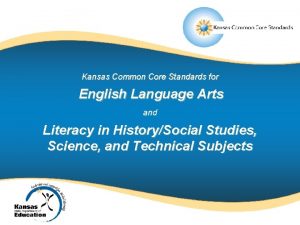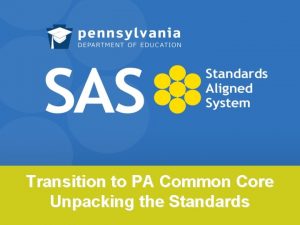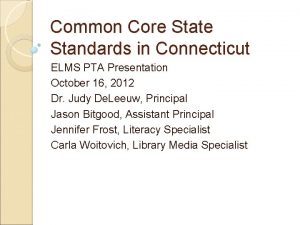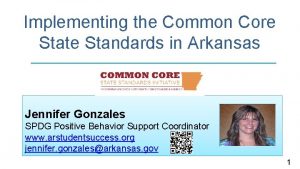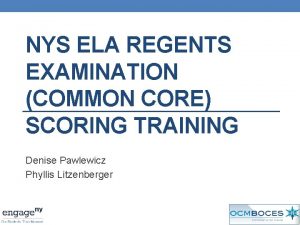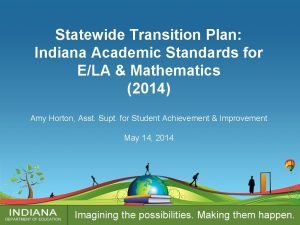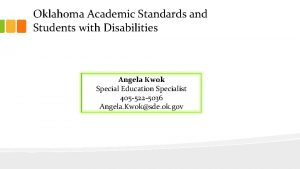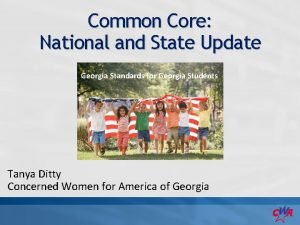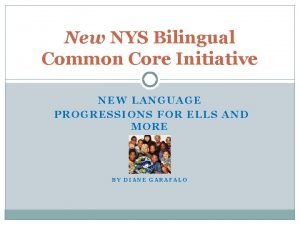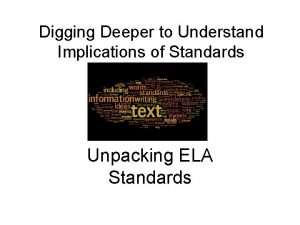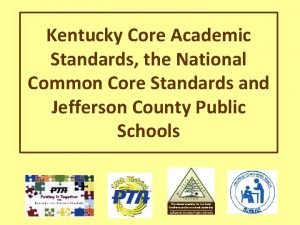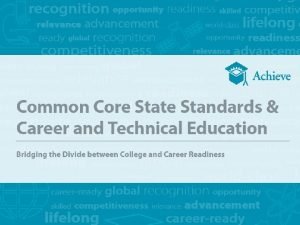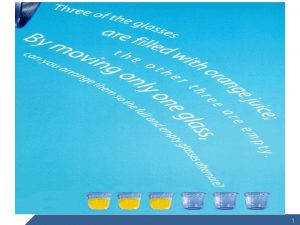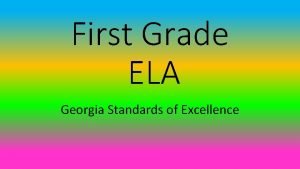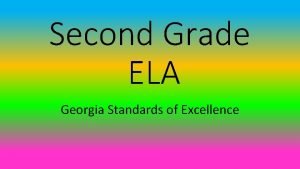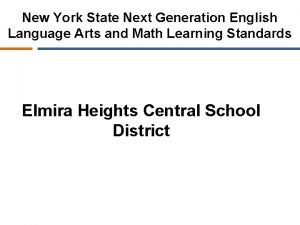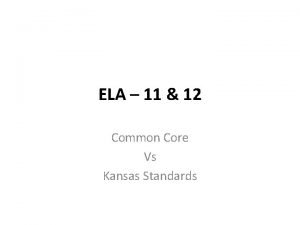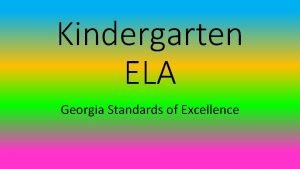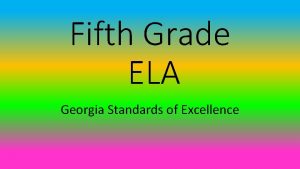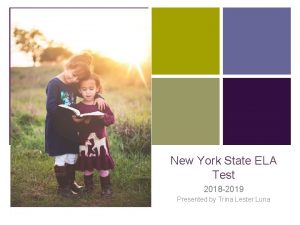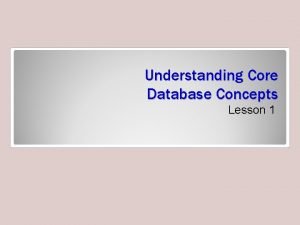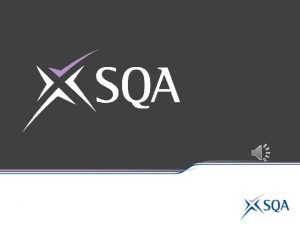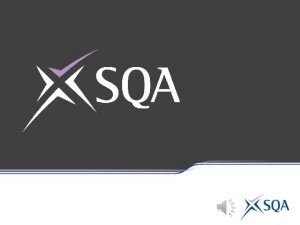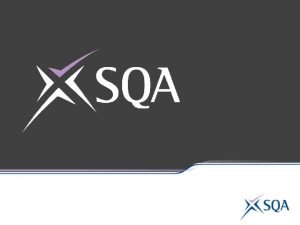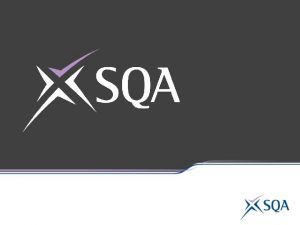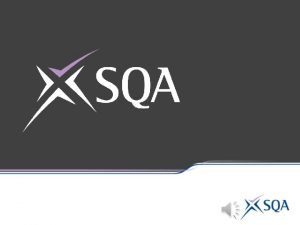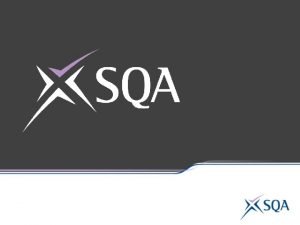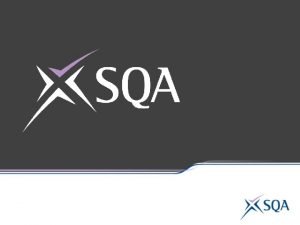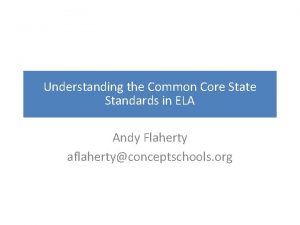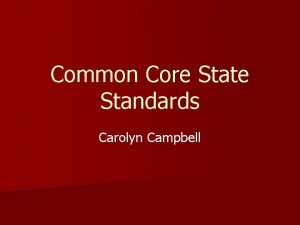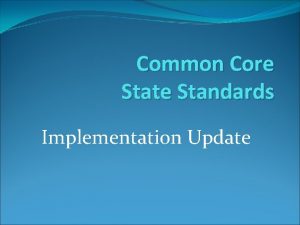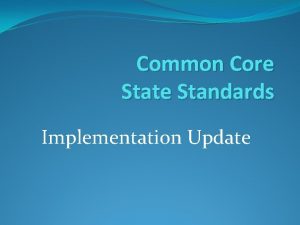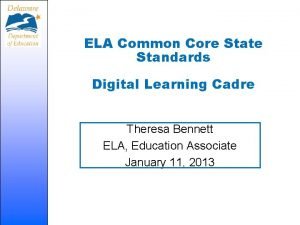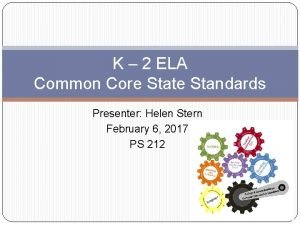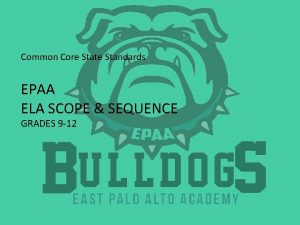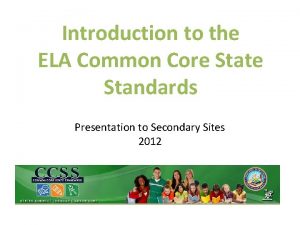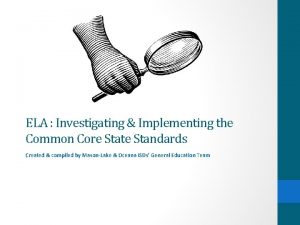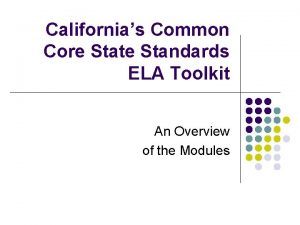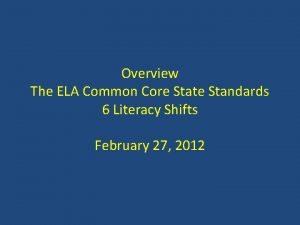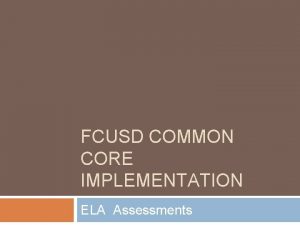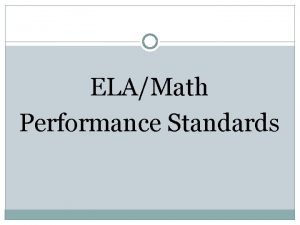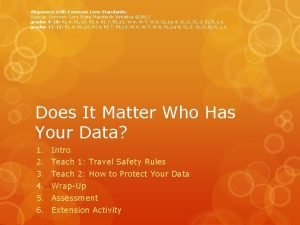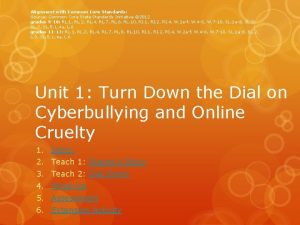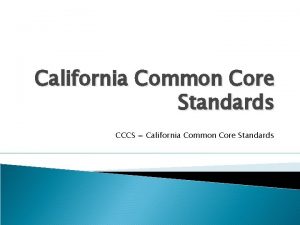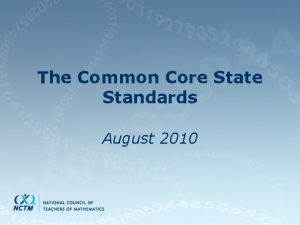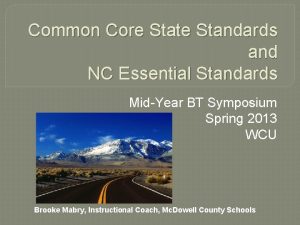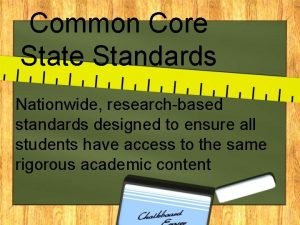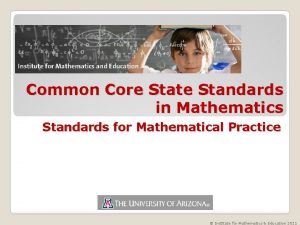Understanding the Common Core State Standards in ELA































- Slides: 31

Understanding the Common Core State Standards in ELA Andy Flaherty aflaherty@conceptschools. org

ELA Common Core Framework “What” students should know and be able to do at each grade level and band. Standard Statements by Grade Level Strands The major areas or disciplines of study within each content area. Topics The main focus of the content within each strand. Standards Statements by Grade Level

English Language Arts Common Core Standards Reading Strand Writing Strand Speaking and Listening Strand Language Strand

English Language Arts Common Core Standards Reading Strand Writing Strand Speaking and Listening Topic Topic Language Strand Topic

Range of Reading and Level of Text Complexity Print Concepts Phonological Awareness Phonics and Word Recognition Fluency Standard Statement 1 Standard Statement 2 Standard Statement 3 Standard Statement 4 and Ideas Integration of Knowledge Craft and Structure Standard Statement 10 Standard Statement 9 Standard Statement 8 Standard Statement 7 Standard Statement 6 Standard Statement 5 Standard Statement 4 Standard Statement 3 Key Ideas and Details Range of Reading and Level of Text Complexity Integration of Knowledge and Ideas Craft and Structure Key Ideas and Details Reading: Literature Standard Statement 2 Standard Statement 10 Standard Statement 9 Standard Statement 8 Standard Statement 7 Standard Statement 6 Standard Statement 5 Standard Statement 4 Standard Statement 3 Standard Statement 2 Standard Statement 1 Reading Strand Reading: Informational Text Reading: Foundational Skills

Writing Strand Text Types and Purposes Standard Statement 1 Standard Statement 2 Standard Statement 3 Production and Distribution of Writing Standard Statement 4 Standard Statement 5 Standard Statement 6 Research and Presentation of Knowledge Standard Statement 7 Standard Statement 8 Standard Statement 9 Range of Writing Standard Statement 10

3 Primary Text Types 1. Argument “Write arguments to support claims with clear reasons and relevant evidence. ” 2. Informative/Explanatory Texts “Write informative/explanatory texts to examine a topic and convey ideas, concepts, and information through the selection, organization, and analysis of relevant content. ” 3. Narrative Texts “Write narratives to develop real or imagined experiences or events using effective technique, relevant descriptive details, and well-structured event sequences. ”

Speaking and Listening Strand Comprehension and Collaboration Standard Statement 1 Standard Statement 2 Standard Statement 3 Presentation of Knowledge and Ideas Standard Statement 4 Standard Statement 5 Standard Statement 6

Language Strand Conventions of Standard English Standard Statement 1 Standard Statement 2 Knowledge of Language Standard Statement 3 Vocabulary Acquisition and Use Standard Statement 4 Standard Statement 5 Standard Statement 6

Vocabulary Acquisition and Use Knowledge of Language Speaking and Listening Strand Conventions of Standard English Presentation of Knowledge and Ideas Writing Strand Comprehension and Collaboration Range of Writing Research to Build Knowledge Production and Distribution of Writing Reading Strand Text Types and Purposes Range of Reading and Level of Text Complexity Integration of Knowledge and Ideas Craft and Structure Key Ideas and Details English Language Arts Common Core Standards Language Strand

Standard Statement Topic 6 Standard Statements Standard Statement Topic Speaking and Listening Strand Standard Statement Topic 10 Standard Statements Standard Statement Topic Writing Strand Standard Statement Foundational Skills (4) K- 5 only Standard Statement Topic 24 Standard Statements Standard Statement Topic Informational Text (10) Standard Statement (10) Topic Literature Standard Statement Standard Statement Reading Strand Language Strand 6 Standard Statements


English Language Arts Standards » Reading: Literature » Grade 7 Key Ideas and Details 1. Cite several pieces of textual evidence to support analysis of what the text says explicitly as well as inferences drawn from the text. 2. Determine a theme or central idea of a text and analyze its development over the course of the text; provide an objective summary of the text. 3. Analyze how particular elements of a story or drama interact (e. g. , how setting shapes the characters or plot). Craft and Structure 4. Determine the meaning of words and phrases as they are used in a text, including figurative and connotative meanings; analyze the impact of rhymes and other repetitions of sounds (e. g. , alliteration) on a specific verse or stanza of a poem or section of a story or drama. 5. Analyze how a drama’s or poem’s form or structure (e. g. , soliloquy, sonnet) contributes to its meaning. 6. Analyze how an author develops and contrasts the points of view of different characters or narrators in a text. Integration of Knowledge and Ideas 7. Compare and contrast a written story, drama, or poem to its audio, filmed, staged, or multimedia version, analyzing the effects of techniques unique to each medium (e. g. , lighting, sound, color, or camera focus and angles in a film). 8. (Not applicable to literature) 9. Compare and contrast a fictional portrayal of a time, place, or character and a historical account of the same period as a means of understanding how authors of fiction use or alter history. Range of Reading and Level of Text Complexity 10. By the end of the year, read and comprehend literature, including stories, dramas, and poems, in the grades 6– 8 text complexity band proficiently, with scaffolding as needed at the high end of the range.

English Language Arts Standards » Writing» Grade 7 Text Types and Purposes *1. Write arguments to support claims with clear reasons and relevant evidence. *2. Write informative/explanatory texts to examine a topic and convey ideas, concepts, and information through the selection, organization, and analysis of relevant content. *3. Write narratives to develop real or imagined experiences or events using effective technique, relevant descriptive details, and well-structured event sequences. Production and Distribution of Writing 4. Produce clear and coherent writing in which the development, organization, and style are appropriate to task, purpose, and audience. (Grade-specific expectations for writing types are defined in standards 1– 3 above. ) 5. With some guidance and support from peers and adults, develop and strengthen writing as needed by planning, revising, editing, rewriting, or trying a new approach, focusing on how well purpose and audience have been addressed. 6. Use technology, including the Internet, to produce and publish writing and link to and cite sources as well as to interact and collaborate with others, including linking to and citing sources. Research to Build and Present Knowledge 7. Conduct short research projects to answer a question, drawing on several sources and generating additional related, focused questions for further research and investigation. 8. Gather relevant information from multiple print and digital sources, using search terms effectively; assess the credibility and accuracy of each source; and quote or paraphrase the data and conclusions of others while avoiding plagiarism and following a standard format for citation. *9. Draw evidence from literary or informational texts to support analysis, reflection, and research. Range of Writing 10. Write routinely over extended time frames (time for research, reflection, and revision) and shorter time frames (a single sitting or a day or two) for a range of discipline-specific tasks, purposes, and audiences.

Common Core Coding • • • RL = Reading for Literature RI = Reading for Information RF = Reading Foundations W = Writing SL = Speaking and Listening L = Language

Sample Code Reading Literature Standard 2 RL. 1. 2 Grade 1

Additional Components Common Core Standards • Anchor standards (K-12) • Literacy standards for History/Social Studies, Science and other Technical Subjects (Grades 6 -12) • Appendix A – Text complexity • Appendix B – Illustrative texts • Appendix C – Student writing exemplars • Language Progressive Skills (Grades 3 -12)

Several Key Shifts • Spotlight on what students read: ‒ Complexity ‒ Range • Close analysis of texts with evidence to back up claims and conclusions • Writing to sources • Research (short projects)

Several Key Shifts • Marshaling arguments • Academic vocabulary • Working independently • Close, slow reading • Evidence, evidence

Ten Guiding Principles 1. Make close reading of texts central to lesson 2. Structure majority of instruction so all students read grade-level complex texts 3. Emphasize informational texts from early grades on 4. Provide scaffolding that does not preempt or replace text 5. Ask text-dependent questions

Ten Guiding Principles 6. Provide extensive research and writing opportunities (claims and evidence) 7. Offer regular opportunities for students to share ideas, evidence and research 8. Offer systematic instruction in vocabulary 9. Provide explicit instruction in grammar and conventions 10. Cultivate students’ independence -from ODE’s Department of ELA, 2011

Comparative Analysis • Deeper look at how revised standards align to 2001 standards • By grade level, will show: – What is same – What is new – What is no longer present • Recently released by ODE • • Language Comparative Analysis K-12 Reading Comparative Analysis K-12 Speaking and Listening Comparative Analysis K-12 Writing Comparative Analysis K-12

Grade 6 – Reading Comparative Analysis

Grade 9 -10 – Reading Comparative Analysis

Examples of complex texts • Amos and Boris, William Steig (3 rd Grade) • Letter to Thomas Jefferson (7 th Grade) • Beloved excerpt, Toni Morrison (11 th-12 th grades)

Amos and Boris, William Steig

Yet she knew Sethe’s greatest fear was the same one Denver had in the beginning – that Beloved might leave. That before Sethe could make her understand what it meant – what it took to drag the teeth of that saw under the little chin; to feel the baby blood pump like oil in her hands; to hold her face so her head would stay on; to squeeze her so she could absorb, still, the death spasms that shot through that adored body, plump and sweet with life – Beloved might leave. Leave before Sethe could make her realize that worse than that – far worse – was what Baby Suggs died of, what Ella knew, what Stamp saw and what made Paul D tremble. That anybody white could take your whole self for anything that came to mind. Not just work, kill, or maim you, but dirty you. Dirty you so bad you couldn’t like yourself anymore. Dirty you so bad you forgot who you were and couldn’t think it up. -from Beloved, Toni Morrison

Final Thoughts The Common Core does NOT: • Tell teachers HOW to teach • Tell all that can or should be taught • Focus on personal connections The Common Core DOES: • • Lift the level of teaching Require close reading and evidence needs to be socially supported, collaborative, motivating the school learns how to learn together

Resources • www. corestandards. org • www. commoncore. org • ODE information: Academic Content Standards>English Language Arts>Common Core Standards and Model Curriculum> • “Bringing the Common Core to Life” http: //vimeo. com/channels/parccinstitute#25 242442

What does Common Core mean for administrators? • Professional Learning Communities within schools to deconstruct standards and create common rubrics • School-wide literacy focus • Focus on all ELA standards, not just those tested by current state tests • Systematic and explicit and authentic writing instruction

• Research has also shown that simply access to books they can and want to read is just as effective as summer school (Arlington and Mc. Gril -Franzen, 2008; Krashen, 2004) • 88 Generalizations About Voluntary Reading (Krashen): http: //www. sdkrashen. com/handouts/88 General izations/index. html • Summer reading can contribute to 85% of reading gap • One study of 17 poor schools showed that spending $45 per child on books for summer reading equaled summer school and doubled for the very poorest students
 Kansas english standards
Kansas english standards Unpacking common core standards
Unpacking common core standards Common core state standards ct
Common core state standards ct Common core state standards missouri
Common core state standards missouri Common core state standards arkansas
Common core state standards arkansas Regents part 3 rubric
Regents part 3 rubric Common core ela assessments
Common core ela assessments Indiana state standards ela
Indiana state standards ela Strrea
Strrea Georgia common core standards
Georgia common core standards Bilingual common core standards
Bilingual common core standards Unpacking standards worksheet
Unpacking standards worksheet Common core standards kentucky
Common core standards kentucky Common career technical core standards
Common career technical core standards Achievethecore.org
Achievethecore.org Georgia standards of excellence ela
Georgia standards of excellence ela Georgia ela standards 2nd grade
Georgia ela standards 2nd grade Nys ela standards
Nys ela standards Kansas ela standards
Kansas ela standards Georgia kindergarten reading standards
Georgia kindergarten reading standards 5th grade writing standards georgia
5th grade writing standards georgia Ny state ela test 2018
Ny state ela test 2018 Database basic concepts
Database basic concepts Understanding standards sqa
Understanding standards sqa National 5 pe portfolio understanding standards
National 5 pe portfolio understanding standards Understanding standards pe
Understanding standards pe Sqa advanced higher geography understanding standards
Sqa advanced higher geography understanding standards National 5 understanding standards
National 5 understanding standards Sqa expressive evaluation template
Sqa expressive evaluation template Understanding standards higher art
Understanding standards higher art Sqa understanding standards advanced higher computing
Sqa understanding standards advanced higher computing Sqa higher english understanding standards
Sqa higher english understanding standards
